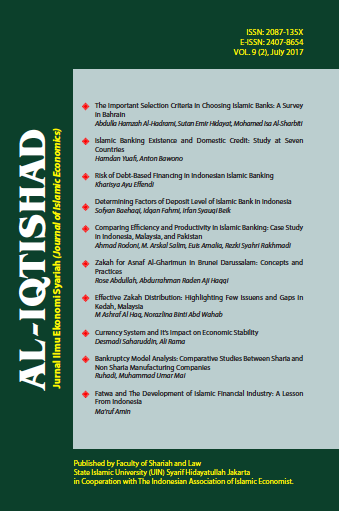Risk of Debt-Based Financing in Indonesian Islamic Banking
DOI:
https://doi.org/10.15408/aiq.v9i2.4821Keywords:
financing risk management, debt-based financing, accounting-basedAbstract
The purpose of this study is to know the risk of debt-based financing in Islamic banking in Indonesia by using an accounting based calculation, those are NPF analysis, Credit risk Z-score and Altman Z-score. This study is telling about the risk of debt-based finacing on Indonesian Islamic banking using an accounting based measurement, those are NPF analysis, Credit Risk Z-score analysis and Altman Z-score analysis. The data was obtained from 2011 to 2015 from the website of each bank. The result is a risk on debt-based financing on Indonesian Islamic banking is low. The measurement using 3 accounting based measurement tool gives a consistent result, that is Indonesian Islamic banking use a debt-based financing have a high financial stability and a low risk.
DOI: 10.15408/aiq.v9i2.4821References
Ahmad, N. H. (2007). Multi-Country Study Of Bank Credit Risk Determinants. International Journal of Banking and Finance, 5(1): 135–152.
Alkassim, F. A. (2005). The Profitability of Islamic and Conventional Banking in the GCC Countries : A Comparative Study. Journal of Review of Islamic Economics, 13: 5-30.
Allen, D. E., & R.J. Powell. (2011). Credit risk measurement methodologies. 19th International Congress on Modelling and Simulation, Perth, Australia., (December), 12–16. Retrieved from http://mssanz.org.au/modsim2011
Altman, E. I., & A. Saunders. (1998). Credit risk measurement : Developments over the last 20 years. Journal of Banking and Finance, 21: 1721–1742.
Ariss, R. T. (2010). Review of Financial Economics Competitive conditions in Islamic and Conventional Banking : A Global Perspective. Review of Financial Economics, 19(3): 101–108.
Barajas, A., et.al. (2013). Too Cold , Too Hot , Or Just Right ? Assessing Financial Sector Development Across the Globe. International Monetary Fund, 1–28.
Beck, T. et.al. (2010). Islamic vs Conventional Banking Business Model, Efficiency and Stability. Policy Research Working Paper, (October).
Beck, T., et.al. (2013). Islamic vs . Conventional Banking : Business Model , Efficiency And Stability. Journal of Banking and Finance, 37(2): 433–447.
Berger, A. N., & Deyoung, R. (1997). Problem Loans and Cost Efficiency in Commercial Banks. Journal of Banking and Finance, 21 (6): 849-870.
Boyd, J. H., & Nicoló, G. De. (2003). The Theory of Bank Risk-Taking and Competition Revisited. International Monetary Fund, 1–29.
Cihak, M., & Hesse, H. (2008). Islamic Banks and Financial Stability : An Empirical Analysis. International Monetary Fund, 1–31.
Das, A., & Ghosh, S. (2009). Determinants of Credit Risk in Indian State-owned Banks: An Empirical Investigation. Reserve Bank of India. Retrieved from http://mpra.ub.uni-muenchen.de/17301/
Ernawati. (2016). Risk Of Profit Loss Sharing Financing : The Case Of Indonesia. Al-Iqtishad: Jurnal Ilmu Ekonomi Syariah (Journal of Islamic Economics),, 8(1): 101–116.
Faye, I. et.al. (2013). The Islamic Finance Promises : Evidence From Africa. Review Of Development Finance, 3: 136–151.
Haron, S. (2004). Determinants of Islamic Bank Profitability. Global Journal of Finance and Economics, 1(1), 1–22.
Hasan, M. & J. Dridi. (2010). The Effects of the Global Crisis on Islamic and Conventional Banks : A Comparative Study. International Monetary Fund, 10: 1–47.
Johnes, J. et.al (2012). A Comparison of Performance of Islamic and Conventional Banks 2004 to 2009. (Working Paper). Lancaster: Lancaster University
Jiménez, G. et.al. (2007). How Does Competition Impact Bank Risk-Taking ? Federal Reserve Bank Of San Francisco Working Paper Series, (September).
Kabir, Md. N., et.al. (2015). Comparative Credit Risk in Islamic and Conventional Banking. Pacific-Basis Finance Journal, 34: 327-353.
Kahf, M. (2005). Islamic Banking And Development : An Alternative Banking Concept ?, (March), 1–15.
Kamaruddin, B. H., et.al. (2008). Assessing Production Efficiency of Islamic Banks and Conventional Bank Islamic Windows in Malaysia. International Journal of Business and Management Research, 1(1), 31–48.
Rajhi, W., & Hassairi, S. A. (2013). Islamic Banks And Financial Stability : A Comparative Empirical Analysis Between Mena and Southeast Asian Countries. Region et Developpement, 149–177.
Saunders, A. (2008). Financial Institutions Management, A Risk Management (6th ed). New York: McGraw-Hill. kotabunga
Shahari, F., et.al. (2015). Investigation Of The Expected Loss Of Sharia Credit Instruments In Global Islamic Banks. International Journal Of Managerial, 11(4): 503–512.
Sukmana, R., & S. Suryaningtyas. (2016). Determinants Of Liquidity Risk In Indonesian. Al-Iqtishad: Jurnal Ilmu Ekonomi Syariah (Journal of Islamic Economics), 8(2): 187–200.
Zaini, M., et.al. (2010). Bank Efficiency And Non-Performing Loans : Evidence From Malaysia And Singapore. Prague Economic Papers, 2: 118–132.

